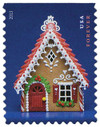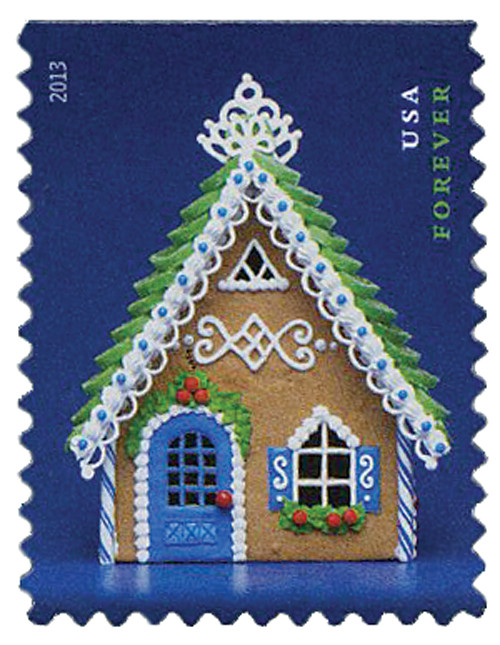
2013 First-Class Forever Stamp,Contemporary Christmas: Gingerbread House with Red Roof and Door
# 4817 - 2013 First-Class Forever Stamp - Contemporary Christmas: Gingerbread House with Red Roof and Door
$0.50 - $3.75
U.S. #4817
2013 46¢ Red Door
Gingerbread Houses
Issue Date: November 6, 2013
City: New York, NY
Quantity: 187,500,000
Printed By: Banknote Corporation of America
Printing Method: Offset
Perforations: Serpentine Die Cut 11
Color: Multicolored
City: New York, NY
Quantity: 187,500,000
Printed By: Banknote Corporation of America
Printing Method: Offset
Perforations: Serpentine Die Cut 11
Color: Multicolored
This stamp is part of a block of four issued for the 2013 holiday season. The gingerbread houses were constructed specifically for the stamp design.
Gingerbread evolved from a centuries-old recipe, but ingredients varied across the globe. Quite happily, the gingerbread houses Americans love today are drastically different from the medieval version.
The name stems from gingerbras, a word borrowed from thirteenth-century France meaning “preserved ginger.” In days preceding refrigeration, bits of the richly scented spice were added to recipes to mask the odor of spoiled meat. By the next century, the name had changed to gingerbread. In the 15th century, one of the earliest-known recipes for the treat was published. It called for breadcrumbs, which were to be boiled in honey, laced with spices, and pressed into wooden molds. In England, 16th century bakers replaced breadcrumbs with flour and added eggs and sugar. Queen Elizabeth I, who loved dessert, is credited with introducing the first gingerbread man.
Houses made of gingerbread and decorated with candy soon became a holiday tradition. In some countries, wine, brandy, or ale are more common ingredients. Bakers in other regions add candied citrus peel, pepper, or anise in place of the ginger. Honey and molasses are often substituted for sugar. Regardless of the recipe, the charming gingerbread cottages are guaranteed to delight family and friends.
U.S. #4817
2013 46¢ Red Door
Gingerbread Houses
Issue Date: November 6, 2013
City: New York, NY
Quantity: 187,500,000
Printed By: Banknote Corporation of America
Printing Method: Offset
Perforations: Serpentine Die Cut 11
Color: Multicolored
City: New York, NY
Quantity: 187,500,000
Printed By: Banknote Corporation of America
Printing Method: Offset
Perforations: Serpentine Die Cut 11
Color: Multicolored
This stamp is part of a block of four issued for the 2013 holiday season. The gingerbread houses were constructed specifically for the stamp design.
Gingerbread evolved from a centuries-old recipe, but ingredients varied across the globe. Quite happily, the gingerbread houses Americans love today are drastically different from the medieval version.
The name stems from gingerbras, a word borrowed from thirteenth-century France meaning “preserved ginger.” In days preceding refrigeration, bits of the richly scented spice were added to recipes to mask the odor of spoiled meat. By the next century, the name had changed to gingerbread. In the 15th century, one of the earliest-known recipes for the treat was published. It called for breadcrumbs, which were to be boiled in honey, laced with spices, and pressed into wooden molds. In England, 16th century bakers replaced breadcrumbs with flour and added eggs and sugar. Queen Elizabeth I, who loved dessert, is credited with introducing the first gingerbread man.
Houses made of gingerbread and decorated with candy soon became a holiday tradition. In some countries, wine, brandy, or ale are more common ingredients. Bakers in other regions add candied citrus peel, pepper, or anise in place of the ginger. Honey and molasses are often substituted for sugar. Regardless of the recipe, the charming gingerbread cottages are guaranteed to delight family and friends.









